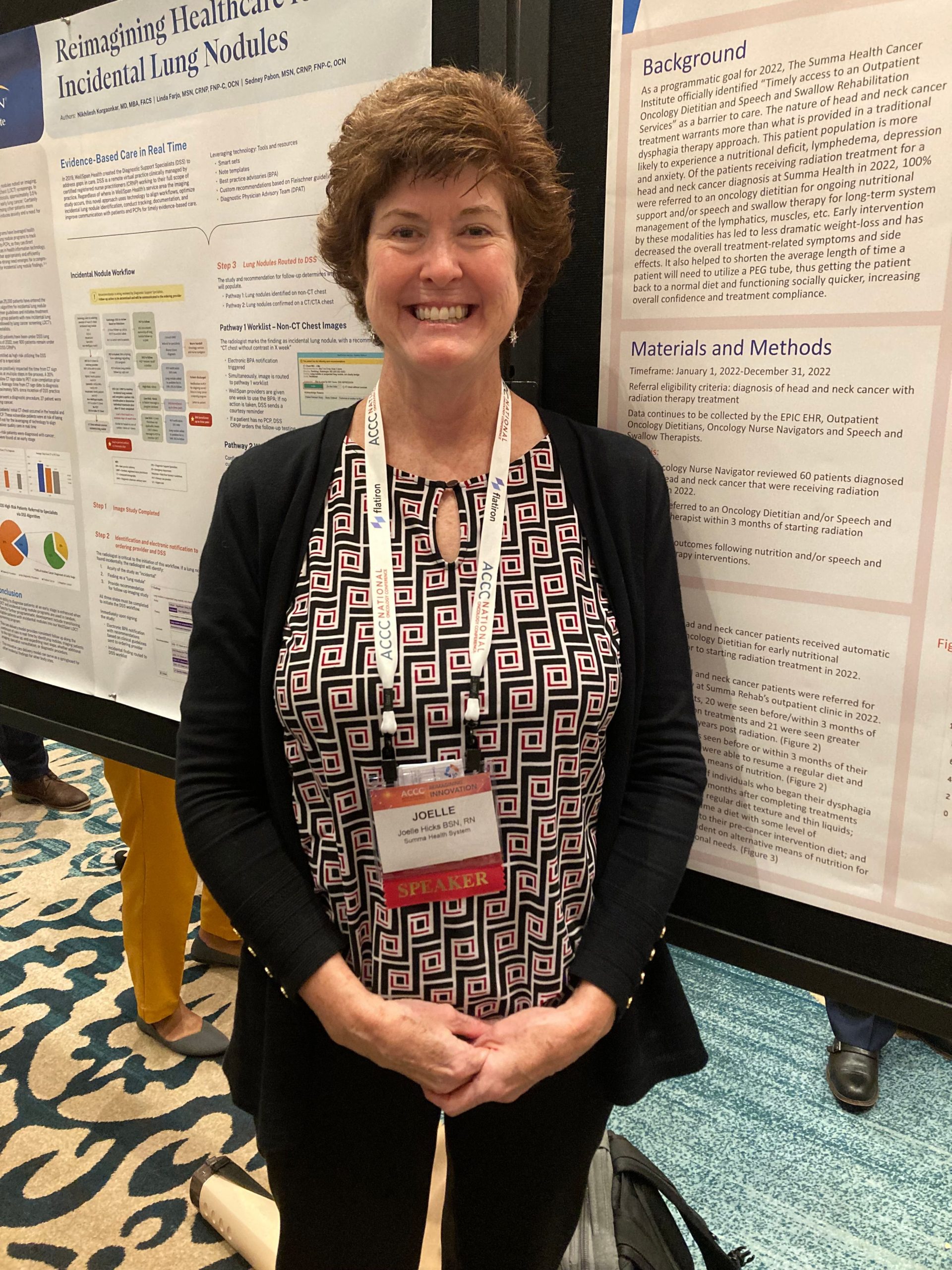Cancer and neoplasms
Streamlined Referral Intervention Sees Great Success Among Patients With Head/Neck Cancer
Joelle Hicks, BSN, RN, Summa Health Cancer Institute
Between January 1 and December 31, 2022, 100% of patients with head and neck cancer undergoing radiation treatment at Summa Health Cancer Institute in Ohio were referred to an oncology dietician to receive ongoing nutritional support plus speech and swallow therapy to manage the adverse effects (AEs) of their treatment over the long term. Timely access to an outpatient oncology dietician had previously been identified as a top barrier to care, according to a poster1 presented at the recent Association of Community Cancer Centers 40th National Oncology Conference.
“Head and neck cancer is not rare, but it is becoming more common, especially with HPV [human papillomavirus]–related head and neck cancers,” noted Joelle Hicks, BSN, RN, an oncology nurse navigator who presented the poster. “We had some difficulty with our processes for referral, so we wanted to work on simplifying that process.”
Not only is high-risk HPV increasingly causing oropharyngeal squamous cell carcinomas when it infect the mouth and throat, but it has also been shown to be the culprit of 70% of oropharyngeal cancers in the United States alone.2,3
According to the present research, there is a greater likelihood of nutritional deficit, lymphedema, depression, and anxiety among patients who have head and neck cancers. Therefore, benefits of early intervention referral to an oncology dietician include weight maintenance, decreased symptoms and AEs, and less time having to use a percutaneous endoscopic gastrostomy (PEG), or feeding, tube.
Initially, 60 patients were included in this analysis through automatic referral to an oncology dietician; ultimately, 41 were referred to dysphagia therapy. All had undergone radiation therapy in 2022 at the Summa Health Cancer Institute, and were referred within 3 months (n = 20) or 3 months or more (n = 21) of starting that treatment. A nutrition screening evaluated their usual body weight, if they did or did not have a recent weight change, whether they gained or lost weight, whether they noticed the weight change, food intake, symptoms in the last 2 weeks, diagnosis, and nutrition screening score.
Among those who participated within 3 months, all were considered to be at a normal or thin weight compared with 5 of the 21 who took 3 or more months to participate. Further in the latter group, 5 patients were on a modified diet and the remaining 11 could not take food in orally and had to use a PEG tube. The interventions they received included the following:
- Prophylactic pharyngocise, or exercises to maintain muscle structure and swallowing function,4 and stretching during radiation treatments
- Clinical and instrumental swallowing assessment
- Lymphedema management, itself including manual lymphatic drainage, compression garments, pneumatic compression devices, and hands-on training
- Myofascial release/manual therapy for the swallowing mechanism to address radiation fibrosis
- Ongoing counseling and training
- Ongoing communication with each patient’s medical team
- Collaborative care from the physical and occupational therapy teams
- Expiratory muscle strength training
Hicks highlighted of her findings that streamlining the early referral process fostered a cohesive care team able to provide more individualized patient care, closer patient monitoring for recurrence with more touchpoints, and a higher level of trust among the care team. In turn, the team members found it easier to communicate with their patients regarding such issues as depression, anxiety, and financial distress. Further, overall cost of care dropped from the more frequent monitoring.
“When a recurrence is identified, it is identified much earlier and treatment is typically less invasive,” Hicks emphasized. “This leads to better outcomes and lower cost for the patient, as well as the organization.”
The 3 primary benefits she identified from this initiative were that building a more streamlined communication process into a solid infrastructure leads to greater continuity of care, early referral/intervention plus ongoing assessment from an oncology dietitian facilitates patient symptom management and prevention of unintended weight consequences, and early referral/intervention plus ongoing assessment from a speech and swallow therapist can better manage treatment-related symptoms and treatment AEs.
References
1. Hicks J. Proactive support interventions for head & neck cancer patients. Poster presented at: Association of Community Cancer Centers 40th National Oncology Conference; October 4-6, 2023; Austin, TX.
2. Husain N, Neyaz A. Human papillomavirus associated head and neck squamous cell carcinoma: controversies and new concepts. J Oral Biol Craniofac Res. 2017;7(3):198-205. doi:10.1016/j.jobcr.2017.08.003
3. HPV and oropharyngeal cancer. CDC. Updated September 12, 2023. Accessed October 17, 2023. https://tinyurl.com/nhfp6wvw
4. Hajdú SF, Wessel I, Dalton SO, Eskildsen SJ, Johansen C. Swallowing exercise during head and neck cancer treatment: results of a randomized trial. Dysphagia. 2022;37(4):749-762. doi:10.1007/s00455-021-10320-5

